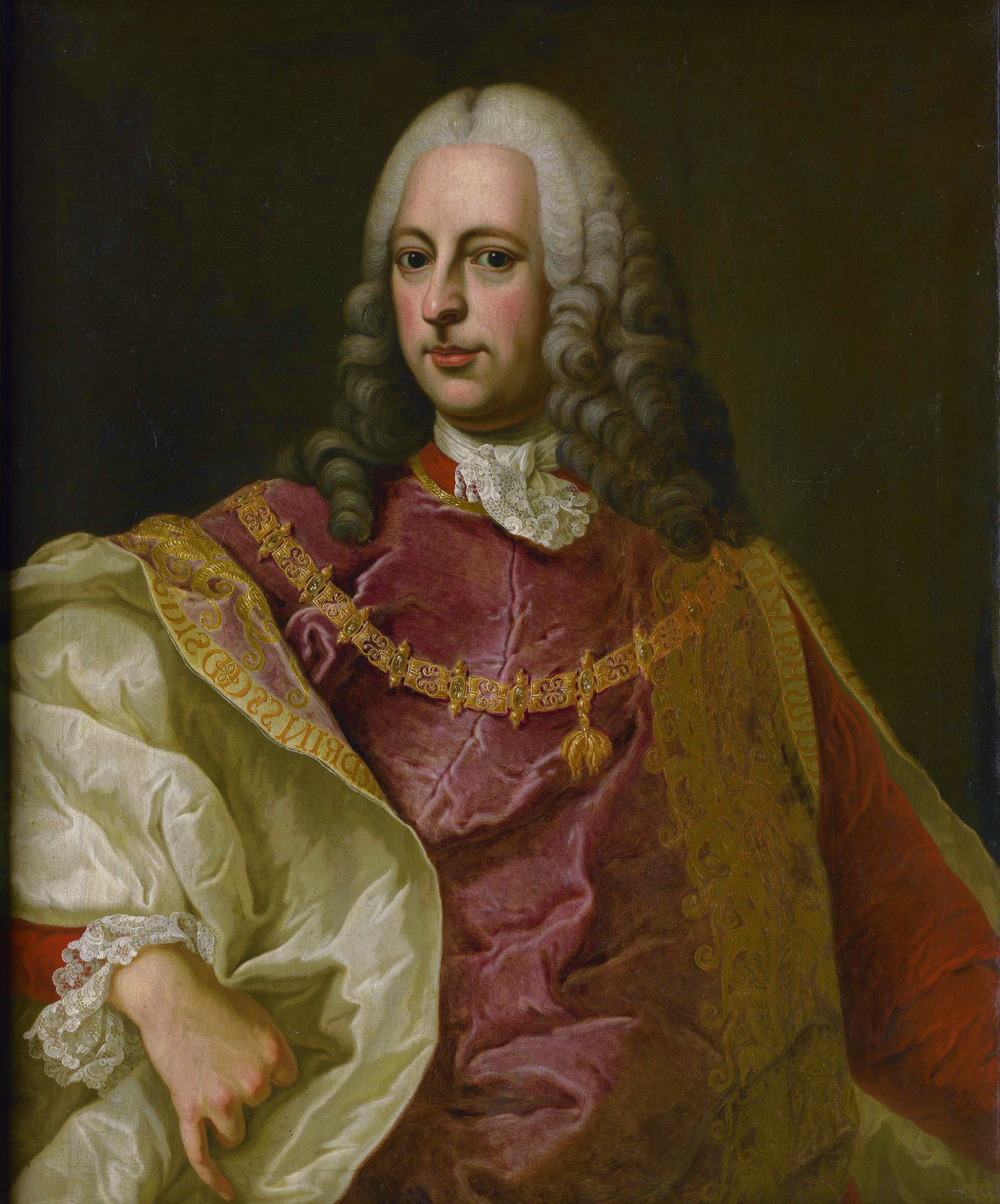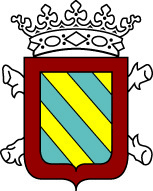|
Count Friedrich August Von Harrach-Rohrau
Count Friedrich August von Harrach-Rohrau, (Vienna, 8 June 1696 – Vienna, 4 June 1749), was plenipotentiary minister of the Austrian Netherlands (1732–1741) and became Governor-General ''ad interim'' in 1741–1744. He was also High Chancellor of Bohemia from 1745 until his death. Early life By birth member of the House of Harrach, he was born as the eldest son and child of Count Aloys Thomas Raimund von Harrach und Rohrau (1669–1742) and his second wife Countess Anna Caecilie von Thannhausen (1674–1721). Marriage and issue He married Princess Maria Eleonora of Liechtenstein (1703 – 17 July 1757), the youngest daughter of Prince Anton Florian of Liechtenstein and his wife Countess Eleonore Barbara von Thun und Hohenstein, on 5 February 1719. They had 16 children: *Franz Anton (13 May 1720 – 25 March 1724) *Maria ''Rosa'' (20 August 1721 – 29 August 1785) Who married her paternal uncle Ferdinand Bonaventura II Anton, Count von Harrach zu Rohrau und Thannha ... [...More Info...] [...Related Items...] OR: [Wikipedia] [Google] [Baidu] |
Archduke Franz Ferdinand Of Austria
Archduke Franz Ferdinand Carl Ludwig Joseph Maria of Austria, (18 December 1863 – 28 June 1914) was the heir presumptive to the throne of Austria-Hungary. His assassination in Sarajevo was the most immediate cause of World War I. Franz Ferdinand was the eldest son of Archduke Karl Ludwig of Austria, the younger brother of Emperor Franz Joseph I of Austria. Following the death of Crown Prince Rudolf in 1889 and the death of Karl Ludwig in 1896, Franz Ferdinand became the heir presumptive to the Austro-Hungarian throne. His courtship of Sophie Chotek, a lady-in-waiting, caused conflict within the imperial household, and their morganatic marriage in 1900 was only allowed after he renounced his descendants' rights to the throne. Franz Ferdinand held significant influence over the military, and in 1913 he was appointed inspector general of the Austro-Hungarian armed forces. On 28 June 1914, Franz Ferdinand and his wife were assassinated in Sarajevo by the 19-year-old ... [...More Info...] [...Related Items...] OR: [Wikipedia] [Google] [Baidu] |
Counts Of Austria
Count (feminine: countess) is a historical title of nobility in certain European countries, varying in relative status, generally of middling rank in the hierarchy of nobility. Pine, L. G. ''Titles: How the King Became His Majesty''. New York: Barnes & Noble, 1992. p. 73. . The etymologically related English term "county" denoted the territories associated with the countship. Definition The word ''count'' came into English from the French ''comte'', itself from Latin ''comes''—in its accusative ''comitem''—meaning “companion”, and later “companion of the emperor, delegate of the emperor”. The adjective form of the word is "comital". The British and Irish equivalent is an earl (whose wife is a "countess", for lack of an English term). In the late Roman Empire, the Latin title ''comes'' denoted the high rank of various courtiers and provincial officials, either military or administrative: before Anthemius became emperor in the West in 467, he was a military ''comes ... [...More Info...] [...Related Items...] OR: [Wikipedia] [Google] [Baidu] |
Nobility From Vienna
Nobility is a social class found in many societies that have an aristocracy. It is normally ranked immediately below royalty. Nobility has often been an estate of the realm with many exclusive functions and characteristics. The characteristics associated with nobility may constitute substantial advantages over or relative to non-nobles or simply formal functions (e.g., precedence), and vary by country and by era. Membership in the nobility, including rights and responsibilities, is typically hereditary and patrilineal. Membership in the nobility has historically been granted by a monarch or government, and acquisition of sufficient power, wealth, ownerships, or royal favour has occasionally enabled commoners to ascend into the nobility. There are often a variety of ranks within the noble class. Legal recognition of nobility has been much more common in monarchies, but nobility also existed in such regimes as the Dutch Republic (1581–1795), the Republic of Genoa (1005–18 ... [...More Info...] [...Related Items...] OR: [Wikipedia] [Google] [Baidu] |
1749 Deaths
Events January–March * January 3 ** Benning Wentworth issues the first of the New Hampshire Grants, leading to the establishment of Vermont. ** The first issue of ''Berlingske'', Denmark's oldest continually operating newspaper, is published. * January 21 – The Teatro Filarmonico, the main opera theater in Verona, Italy, is destroyed by fire. It is rebuilt in 1754. * February – The second part of John Cleland's erotic novel ''Fanny Hill'' (''Memoirs of a Woman of Pleasure'') is published in London. The author is released from debtors' prison in March. * February 28 – Henry Fielding's comic novel ''The History of Tom Jones, a Foundling'' is published in London. Also this year, Fielding becomes magistrate at Bow Street, and first enlists the help of the Bow Street Runners, an early police force (eight men at first). * March 6 – A "corpse riot" breaks out in Glasgow after a body disappears from a churchyard in the Gorbals district. Suspicion fa ... [...More Info...] [...Related Items...] OR: [Wikipedia] [Google] [Baidu] |
1696 Births
Events January–March * January 21 – The Recoinage Act, passed by the Parliament of England to pull counterfeit silver coins out of circulation, becomes law.James E. Thorold Rogers, ''The First Nine Years of the Bank of England'' (Clarendon Press, 1887 p. 41 * January 27 – In England, the ship HMS ''Royal Sovereign'' (formerly ''HMS Sovereign of the Seas'', 1638) catches fire and burns at Chatham, after 57 years of service. * January 31 – In the Netherlands, undertakers revolt after funeral reforms in Amsterdam. * January – Colley Cibber's play ''Love's Last Shift'' is first performed in London. * February 8 (January 29 old style) – Peter the Great who had jointly reigned since 1682 with his mentally-ill older half-brother, Tsar Ivan V, becomes the sole Tsar of Russia when Ivan dies at the age of 29. * February 15 – A plot to ambush and assassinate King William III of England in order to restore King James and the House of Stua ... [...More Info...] [...Related Items...] OR: [Wikipedia] [Google] [Baidu] |
Governors Of The Habsburg Netherlands
The governor ( nl, landvoogd) or governor-general () of the Habsburg Netherlands was a representative appointed by the Holy Roman emperor (1504-1556), the king of Spain (1556-1598, 1621-1706), and the archduke of Austria (1716-1794), to administer the Burgundian inheritance of the House of Habsburg in the Low Countries when the monarch was absent from the territory. The role of the governor-generals significantly changed over time: initially tutors and advisors of Emperor Charles V, who lived at the Palace of Coudenberg, they served as generals during the 80 Years War between the Kingdom of Spain and the Dutch Republic. Frequently, the governor-general was a close relative of the Austrian or Spanish monarchs, though at other times Spanish or German noblemen filled the role. The governor-general was usually based in Brussels. List of governors {, width=80% class="wikitable" !Picture !Name !Took office !Left office !Relationship to monarch !Appointed by , - , align="center", ... [...More Info...] [...Related Items...] OR: [Wikipedia] [Google] [Baidu] |
Archduchess Maria Anna Of Austria (1718–1744)
Archduchess Maria Anna Eleonore Wilhelmine Josepha of Austria (18 September 1718 in Vienna – 16 December 1744 in Brussels) was a member of the House of Habsburg who governed the Austrian Netherlands in the name of her elder sister, Empress Maria Theresa. Life Maria Anna was born at the Hofburg Imperial Palace in Vienna. Her birth was not well received by her father. She and her sister Maria Theresa were the only children of Charles VI, Holy Roman Emperor, and Elisabeth Christine of Brunswick to survive into adulthood. The two sisters were raised in the Imperial Court (''Kaiserhof'') in Vienna. During her youth she met her future brother in law, Francis Stephen of Lorraine and his younger brother Charles Alexander of Lorraine. The two princes were staying in Austria having a good education; their mother Élisabeth Charlotte d'Orléans was in France. In 1725, negotiations with the Queen of Spain, Elisabeth Farnese had Maria Anna as a possible wife of Philip, Duke of Parma, w ... [...More Info...] [...Related Items...] OR: [Wikipedia] [Google] [Baidu] |
Archduchess Maria Elisabeth Of Austria (1680–1741)
Archduchess Maria Elisabeth of Austria (13 December 1680 in Linz – 26 August 1741 in Mariemont, Morlanwelz), was the governor of the Habsburg Netherlands between 1725 and 1741. Life Maria Elisabeth was a daughter of Emperor Leopold I and Eleonore-Magdalena of Pfalz-Neuburg. She was well educated and fluent in Latin, German, French and Italian. She never married. Governor In 1725, she was appointed Prince Eugene of Savoy's successor as the regent governor of the Austrian Netherlands by her brother, Charles VI. Maria Elisabeth was described as a forceful administrator and a popular regent. Her independent politics, however, were not always appreciated in Vienna. She suspended the Ostend Company in 1727 and closed it in 1731. She had enough financial means at her disposal to uphold an elaborate court which stimulated culture and music. Among others, she patronized Jean-Joseph Fiocco Jean-Joseph Fiocco (15 December 1686 – 30 March 1746) was a Flemish composer of the high a ... [...More Info...] [...Related Items...] OR: [Wikipedia] [Google] [Baidu] |
Académie Royale De Belgique
The Royal Academies for Science and the Arts of Belgium (RASAB) is a non-governmental association which promotes and organises science and the arts in Belgium by coordinating the national and international activities of its constituent academies such as the National Scientific Committees and the representation of Belgium in international scientific organisations. RASAB was formed as a non-profit organization (Association without lucrative purpose) in 2001 by the Dutch-speaking academy KVAB ( Koninklijke Vlaamse Academie van België voor Wetenschappen en Kunsten i.e. ''Royal Flemish Academy of Belgium for Science and the Arts'') and by the French-speaking academy ARB ( i.e. ''The Royal Academy of Science, Letters and Fine Arts of Belgium''). The association is headquartered in the buildings of the former Royal Stables at the Academy Palace, Hertogsstraat 1 Rue Ducale B-1000 Brussels. History Academies RASAB was founded in 2001 by the two Belgian academies which are connecte ... [...More Info...] [...Related Items...] OR: [Wikipedia] [Google] [Baidu] |
Czech Language
Czech (; Czech ), historically also Bohemian (; ''lingua Bohemica'' in Latin), is a West Slavic language of the Czech–Slovak group, written in Latin script. Spoken by over 10 million people, it serves as the official language of the Czech Republic. Czech is closely related to Slovak, to the point of high mutual intelligibility, as well as to Polish to a lesser degree. Czech is a fusional language with a rich system of morphology and relatively flexible word order. Its vocabulary has been extensively influenced by Latin and German. The Czech–Slovak group developed within West Slavic in the high medieval period, and the standardization of Czech and Slovak within the Czech–Slovak dialect continuum emerged in the early modern period. In the later 18th to mid-19th century, the modern written standard became codified in the context of the Czech National Revival. The main non-standard variety, known as Common Czech, is based on the vernacular of Prague, but is now spoken as an ... [...More Info...] [...Related Items...] OR: [Wikipedia] [Google] [Baidu] |







_with_archducal_coronet_in_circa_1725_by_Frans_Stampart.jpg)
